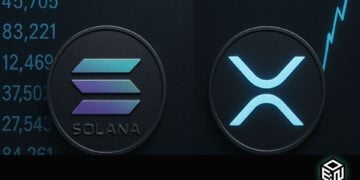- Hyperliquid is a decentralized perpetual futures exchange built on its own ultra-fast Layer 1 blockchain, featuring a fully onchain order book, near-instant finality, and professional-grade trading tools — rivaling centralized exchanges in performance while keeping everything transparent and user-owned.
- With no VC backing and 70% of its HYPE token supply distributed to users, Hyperliquid focuses on community-led growth. Staking, governance, high-yield vaults, and a $1.2B airdrop have made HYPE one of the most active and rewarding tokens in the DeFi space.
- Dominating over 70% of decentralized perps volume, Hyperliquid continues to scale with new apps, staking rewards up to 55%, and future plans for spot markets, mobile upgrades, validator expansion, and cross-chain support — aiming to become DeFi’s all-in-one financial operating system.
Hyperliquid, a high-performance Layer 1 blockchain, is reshaping decentralized derivatives by delivering CEX-grade speed with on-chain transparency. Built for capital markets, it fuses ultra-low latency infrastructure with a fully public, permissionless order book — quickly emerging as one of the hottest DeFi solutions in the space. So, let us dive in and take a closer look at the project
What Is Hyperliquid?
At its core, Hyperliquid is a decentralized exchange focused exclusively on perpetual futures — contracts that let traders bet on crypto price movements without owning the underlying assets. But unlike most decentralized platforms that run on established blockchains like Ethereum or Layer 2s, Hyperliquid stands apart by operating on its own Layer 1 blockchain, built from the ground up with speed and derivatives trading in mind.
This custom blockchain uses a unique consensus protocol to achieve blazing-fast transaction finality and handles an onchain order book that processes trades transparently in real time. This architecture is crucial because it lets Hyperliquid deliver trading performance close to centralized exchanges, without sacrificing user control or decentralization.
Beyond technology, Hyperliquid has staked its claim with a radical community-first approach. Rejecting venture capital money and allocating 70% of its native token supply to users, it flips the script on typical crypto projects where insiders and VCs reap most of the rewards.
What Problems Does It Solve?
DeFi has long struggled with inefficiencies when it comes to derivatives trading. Most decentralized platforms rely on AMMs and liquidity pools, which, while innovative, lead to significant slippage and poor price execution. For traders looking to make large or frequent trades, this can mean costly losses and frustrating experiences.
Hyperliquid breaks this mold by reintroducing the order book — a tried and tested mechanism in traditional finance but rarely seen in decentralized trading due to technical challenges. By building a blockchain tailored for speed and high throughput, Hyperliquid solves the latency and liquidity issues that have plagued other DEXs.
How Does It Work?
Hyperliquid operates on a bespoke Layer 1 blockchain powered by its own HyperEVM environment and the HyperBFT consensus mechanism. This combination is designed to deliver near-instant transaction finality and the capacity to process up to 100,000 orders per second — a remarkable throughput for any decentralized system.
Central to its functionality is a fully onchain perpetual order book. Unlike typical DeFi exchanges that rely on automated market makers (AMMs) and liquidity pools, Hyperliquid matches buyers and sellers directly, in real time, using a price-time priority system. This setup drastically reduces slippage and provides traders with more precise control over their orders, closely mimicking centralized exchange experiences.
Moreover, margins and positions are managed by a decentralized clearinghouse, which supports both isolated and cross-margin trading styles. This means users can either allocate margin specifically to individual trades or share collateral across multiple positions to optimize capital efficiency and risk management.
In addition to this, to ensure fair and accurate pricing, Hyperliquid employs a decentralized oracle system. Validators update price feeds every three seconds from multiple reputable centralized exchanges, which govern funding rates, margin calls, and liquidations. This onchain transparency minimizes price manipulation risks and helps maintain a robust, fair marketplace.
Utility and Offerings
Hyperliquid introduces a comprehensive set of tools and features designed to reshape decentralized trading, combining speed, transparency, and user empowerment. Key components include:
HYPE Token
HYPE is the native token for governance, staking, fee discounts, and gas payments on Hyperliquid’s network. Token holders vote on upgrades, stake for network security, and earn rewards, making HYPE central to the platform’s operation and long-term sustainability.
Perpetual Futures Trading
Hyperliquid offers leveraged perpetual futures trading up to 40x. Traders can speculate or hedge without owning the underlying crypto, enjoying fast execution and transparent pricing tailored for professional and retail traders alike.
Fully Onchain Order Book
Unlike most DeFi platforms, Hyperliquid uses a fully onchain order book. This eliminates slippage and price impact, enabling real-time order matching and improved price discovery, giving users a smooth, centralized-exchange-level trading experience.
Vaults
Vaults let users earn passive income by pooling funds into managed trading strategies. Vault leaders take a profit share while depositors gain exposure to professional trading without active management.
Paper Trading
Paper trading offers a risk-free way to practice strategies and learn the platform. It simulates live market conditions without capital loss, making it an essential tool for newcomers and experienced traders refining their approach.
HyperEVM
HyperEVM is Hyperliquid’s high-performance smart contract environment. Fully compatible with Ethereum tools, it enables developers to build dApps, issue tokens, and create synthetic assets, all benefiting from the platform’s low latency and high throughput.
Order Suite
Hyperliquid supports advanced orders such as market, limit, stop-limit, TWAP, and scale orders. These options enable precise trade execution, allowing users and institutions to implement sophisticated strategies with greater control.
Security and Risk Management
The platform’s validator-driven architecture enforces security and integrity. Margin checks prevent risky trades, open interest caps limit exposure, and withdrawal locks safeguard against front-running, ensuring a stable and secure trading environment.
Ecosystem Highlights
Since launching in 2023, Hyperliquid has grown from a niche derivatives venue into a full-blown DeFi powerhouse.
Some of the key highlights include:
- Over 70% of Perps Market Share – Hyperliquid now dominates the decentralized perpetual space, capturing more than 70% of monthly volume and eclipsing legacy platforms like dYdX and GMX in both liquidity and execution performance.
- Historic $1.2B Airdrop – The HYPE token airdrop distributed $1.2 billion to 94,000 users without VC involvement. This landmark event elevated Hyperliquid’s credibility and set a precedent for transparent, community-first token distribution.
- Sticky User Activity – Unlike most projects that bleed users post-airdrop, Hyperliquid has seen sustained trading volumes in the billions and consistent daily engagement, driven by product depth and trust in the protocol.
- Vaults and Staking TVL Surge – Vaults have attracted tens to hundreds of millions in deposits, while HYPE staking yields of up to 55% continue to lock value into the ecosystem and reward long-term participants.
- Fast-Growing App Ecosystem – Projects like Hyperdrive (lending/yield), Theo (liquidity infra), PvP.trade (gamified bots), HypurrFi and HypurrFun (memecoin and DeFi primitives) are rapidly expanding the utility layer across the protocol.
- Becoming DeFi’s Financial OS – With native tools like paper trading, referral incentives, vault tracking, and integrations like Nansen, Hyperliquid is positioning itself as an all-in-one financial operating system for decentralized capital markets.
Roadmap and Plans Ahead
Looking forward, Hyperliquid has clear ambitions to broaden its scope and deepen its impact:
- Introduction of Spot Markets – Expanding beyond perpetual futures to support spot trading will open the platform to a wider user base.
- Mobile and Interface Upgrades – Enhancing accessibility with more intuitive and mobile-friendly apps will make trading easier for newcomers and veterans alike.
- Validator Network Expansion – Increasing the number and diversity of validators will improve decentralization and network resilience.
- Developer Ecosystem – Opening APIs and encouraging third-party dApps will foster innovation and extend platform utility.
- Cross-Chain Asset Support – Integrating additional blockchains and expanding asset options will broaden market access.
- Advanced Staking and Governance – Rolling out more flexible staking mechanisms and governance tools will deepen user engagement and community control.
Final Thoughts
In conclusion, Hyperliquid has carved out a serious position in the DeFi arena by doing what others have only promised—delivering centralized-level speed and experience without compromising on-chain transparency and user ownership. Its community-first tokenomics, robust infrastructure, and expanding utility layer position it as more than just another DEX. So, as the platform evolves and DeFi matures, it will be interesting to see how far Hyperliquid can push the boundaries of decentralized trading.














